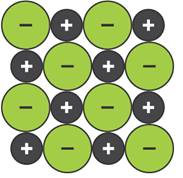
Interpretation:
The formation of bonds between ions and its resulting structure.
Concept introduction:
Chemical compounds are formed when the atoms, ions or molecules of two substances are attracted towards each other forming a
Answer to Problem 15SSC
The ionic compound is formed by ions that held by electrostatic forces and it has a crystalline structure.
Explanation of Solution
Compounds that are made up of ions are said to be ionic compounds. The atoms that gain electrons forms negatively charged particle and atoms lose electrons to form positively charged particles. From the periodic table, the groups containing metals will lose electrons to become positively charged particles and non-metals will gain electrons to form negatively charged particles.
The ionic compounds are formed due to the force of attraction between the positively charged and negatively charged ions. The electrostatic forces between the ions holds the ions together. The ions repeat with regular and repeated pattern of arrangement which is termed as ionic lattice.

The ions which are held by electrostatic forces are arranged in lattice and its three dimensional structure gives crystals having a regular shape.
The ionic compound is formed by ions that held by electrostatic forces and it has a crystalline structure.
Chapter 7 Solutions
Chemistry: Matter and Change
Additional Science Textbook Solutions
Chemistry: The Central Science (13th Edition)
Essential Organic Chemistry (3rd Edition)
Chemistry: The Central Science (14th Edition)
Chemistry: Structure and Properties
CHEMISTRY-TEXT
Introductory Chemistry (5th Edition) (Standalone Book)
 ChemistryChemistryISBN:9781305957404Author:Steven S. Zumdahl, Susan A. Zumdahl, Donald J. DeCostePublisher:Cengage Learning
ChemistryChemistryISBN:9781305957404Author:Steven S. Zumdahl, Susan A. Zumdahl, Donald J. DeCostePublisher:Cengage Learning ChemistryChemistryISBN:9781259911156Author:Raymond Chang Dr., Jason Overby ProfessorPublisher:McGraw-Hill Education
ChemistryChemistryISBN:9781259911156Author:Raymond Chang Dr., Jason Overby ProfessorPublisher:McGraw-Hill Education Principles of Instrumental AnalysisChemistryISBN:9781305577213Author:Douglas A. Skoog, F. James Holler, Stanley R. CrouchPublisher:Cengage Learning
Principles of Instrumental AnalysisChemistryISBN:9781305577213Author:Douglas A. Skoog, F. James Holler, Stanley R. CrouchPublisher:Cengage Learning Organic ChemistryChemistryISBN:9780078021558Author:Janice Gorzynski Smith Dr.Publisher:McGraw-Hill Education
Organic ChemistryChemistryISBN:9780078021558Author:Janice Gorzynski Smith Dr.Publisher:McGraw-Hill Education Chemistry: Principles and ReactionsChemistryISBN:9781305079373Author:William L. Masterton, Cecile N. HurleyPublisher:Cengage Learning
Chemistry: Principles and ReactionsChemistryISBN:9781305079373Author:William L. Masterton, Cecile N. HurleyPublisher:Cengage Learning Elementary Principles of Chemical Processes, Bind...ChemistryISBN:9781118431221Author:Richard M. Felder, Ronald W. Rousseau, Lisa G. BullardPublisher:WILEY
Elementary Principles of Chemical Processes, Bind...ChemistryISBN:9781118431221Author:Richard M. Felder, Ronald W. Rousseau, Lisa G. BullardPublisher:WILEY





